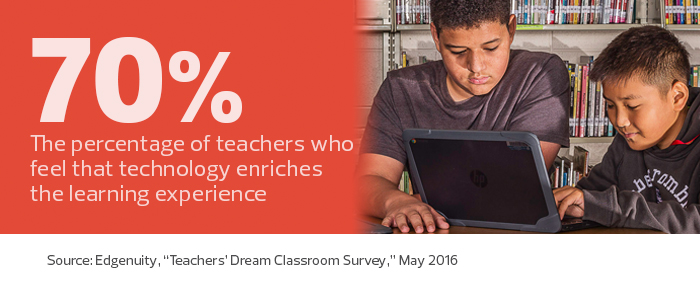Schools Tap Students to Provide Enough IT Help Desk Support
At first, when Indian Prairie School District began to feel the pinch of rising demands on its help desk support, it wasn’t sure how it would meet the growth in requests.
It’s a big district in suburban Chicago, with about 28,000 students across 33 schools. Given expanding IT needs in classrooms, IPSD decided to launch a program that would tap students as support aides, says Stan Gorbatkin, assistant superintendent for technology services.
The district just completed its first year of using students in tech squads at the middle school level. Instead of setting up a traditional help desk in each school’s media room as many student-run programs do, IPSD embedded its 200 volunteers strategically in classrooms, Gorbatkin says. When students experience Wi-Fi or login issues or need help with educational apps or websites, volunteers are there to handle needs on the spot, he says.
Students are grouped in interdisciplinary teams at the district’s seven middle schools, each with three to five core teachers as team leaders.
SIGN UP: Get more news from the EdTech newsletter in your inbox every two weeks!
Tech-Savvy Serve as Classroom Resources
“We’re starting to see the students become more of an instructional resource,” Gorbatkin says. “They’re recommending apps and helping each other. It fosters teamwork and leadership, and empowers the kids.”
Expanding on last year’s middle-level initiative, this year, IPSD introduced student-led drop-in stations at its three high schools, where it launched a one-to-one initiative using HP Chromebooks. “We have about 2,000 freshmen this fall,” Gorbatkin says. “Guess which students are going to jump in and be the geniuses?”

Training Students in IT Optimizes the Department
Like many school districts that have adopted one-to-one computing, Bethlehem Central School District faced budget cuts as its IT needs grew.
The Albany County, N.Y., district’s Justin Brown and Navaar Johnson proposed what was then considered an unusual solution: Recruit students to join the help desk at Bethlehem High.
“We needed to find an innovative way to increase our output without really increasing staff,” says Brown, senior network and systems engineer. “And we wanted to create a technology community that fosters professional growth and collaboration and adds to our ability to support teaching and learning.”
That was six years ago. Today, Bethlehem’s help desk employs as many as 23 students each year. They volunteer 10 to 15 hours a week to help students and staff set up passwords, install software and master the ins and outs of the Google for Education suite. The tech they help to support runs the gamut, from Acer Chromebooks to Dell OptiPlex 7440 all-in-one desktops, with a range of laptops and tablets in between.
Although students don’t receive school credit for participation, they gain valuable experience. The extra hands have also helped to slash help desk response times in half. Students help themselves by helping others — and everyone benefits, Brown says.
“Our goal is to provide students with as close to a real-world work experience as possible,” adds Johnson, a network and systems engineer and former Bethlehem High student who returned to work at the school after college.
Student-run help desks are becoming more common as more schools launch one-to-one computing initiatives, says April Requard, an instructional technology specialist at Albuquerque Public Schools in New Mexico.
“It’s starting to be a trend,” she says. “Teachers are busy, tech departments are overwhelmed, and there’s more technology in schools than ever before. The one untapped resource is our students, and often they know more than we do about troubleshooting technology.”
Help Desks Let Students Explore Tech Passions
For three years, Jennifer Scheffer ran the student help desk at Burlington High School, 15 miles north of Boston. Its help desk became a model for school districts around the country.
BHS students create instructional videos and offer hardware support, connecting tablets to the school network and doing basic troubleshooting on the Lenovo Chromebooks and tablets in each classroom. The high school operates the help desk as an honors-level course for a dozen students, who receive 2.5 credits for a semester of participation.

“They were the first line of tech support for teachers,” she says. “Everything the students worked on was real-world, and we put heavy emphasis on providing customer service. If there was a problem they couldn’t solve, then it would be escalated to our IT department.”
Scheffer, a Google for Education certified educator, tried to emulate the search and advertising giant by implementing the company’s famous 20 percent rule, which gave her students free time to work on personal projects. Two of them built an app; another organized a TEDx-style event on campus. When Scheffer switched schools last fall and became an instructional technology specialist at Fox Hill Elementary, she brought the concept to the grade school.
There, her fourth- and fifth-graders make and share videos on YouTube about how to use educational apps. The roughly three dozen students who’ve volunteered have become digital role models for other students, she says. Unlike the high school students, the elementary volunteers do not receive grades or class credit for their time.
“They come in during recess,” she says. “They’d rather be on the help desk creating resources than going out on the playground.”
Community IT Partnerships Expand Connections
Requard recommends finding creative ways to serve the local community. She has created programs to let kids share their skills with teachers and the public.
During what she calls “app speed dating,” fourth- and fifth-graders run teachers through apps in three-minute rotations. And, at monthly forums, adults in the community get tech questions answered by 10- and 11-year-olds.
“We should move beyond just having students fix things and make more of a connection to how technology can help people’s lives,” she says. “I challenge and encourage teachers to think beyond the help desk. It should also be about what we can do to help serve others.”








